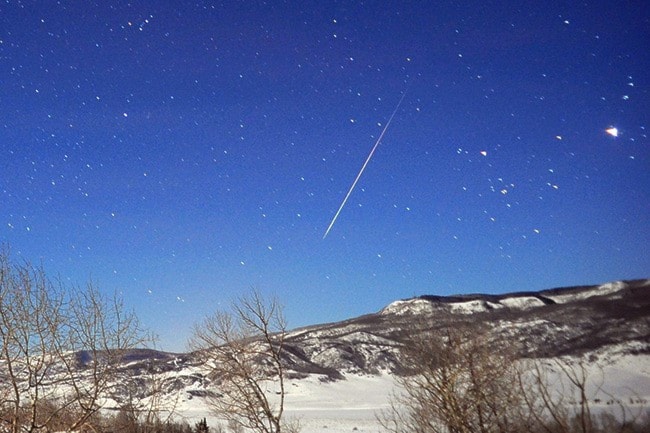Quadrantid Meteor Shower
These meteors are active from Dec. 28 to Jan 12, and on nights when the moon sets early, astronomers predict you can see up to 120 meteors per hour, weather permitting of course. The shooting stars will appear to be come from just below Ursa Major. This is the site of a now defunct constellation named Quadrans Murali, from which the meteor shower takes its name.
The Planets
Venus will be very prominent in the evenings for this first month of 2017. It will be the brightest object in the sky, with the exception of the moon, and can be found in the southwest. This is supposed to be the best viewing of our sister planet in five years, so take a good look if you have a telescope.
Mars will be easy to find all month as it will be hovering fairly close above and to the left of Venus. You will be able to pick it out from the rest of the stars because of its orange-red colour and comparative brightness. Unfortunately, its brightness will fade as January continues. On Jan. 31, it will form a tight triangle with Venus and the moon, which should be very photogenic for those with cameras and steady hands or tripods.
The brightest object to the immediate lower right of Mars is Neptune. The gap between the two planets will increase over January, and by Jan. 12 Neptune will appear to pass just south of Venus before continuing west.
In the later half of January, Mars and Venus will move into the constellation Pisces, the Fish, where they will join a long term resident, Uranus. This outer planet has been swimming about the region since 2013. It will be bright enough to see with the naked eye, though binoculars might be needed in light-polluted skies. To confirm that you have found the planet look through a telescope to see its striking blue-green colour.
Jupiter dominates the morning sky throughout January. It rises around 1 a.m. on Jan. 1 and by the end of the month it will rise around 11p.m. Jupiter climbs the highest in the south around twilight, which is the best time to look at it through a telescope. This is because the planet’s light has to travel through less of Earth’s atmosphere on its journey to our eyes. If you are fortunate enough to have a telescope, or a friend with one, you should be able to spot Jupiter’s four Galilean moons: Io, Europa, Ganymede and Callisto.
Saturn rises 90 minutes before the Sun on Jan. 1 and three hours before our star on Jan. 31. The ringed world is brighter than the stars behind it as it rises in the southeast. Using a telescope, the best views of the planet will be later in the month when it climbs highest before dawn. The rings will be tilted 27 degrees to our line of sight.
Mercury comes in to view in the southeast shortly before dawn this month. It will reach its greatest height on Jan. 19 when it rises a half-hour before sunrise.
Several astronomy events will take place in 2017, from the regular meteor showers to a full solar eclipse in the U.S. on Aug. 21, and I look forward to writing about all these events for you. Happy New Year!
By Samantha Bell
